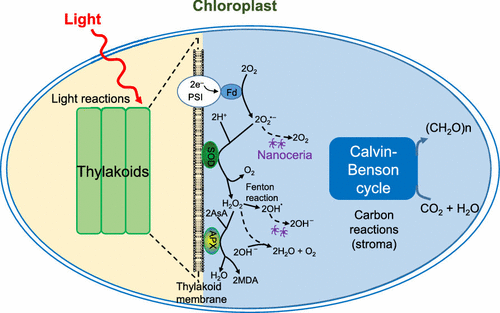Our official English website, www.x-mol.net, welcomes your
feedback! (Note: you will need to create a separate account there.)
Anionic Cerium Oxide Nanoparticles Protect Plant Photosynthesis from Abiotic Stress by Scavenging Reactive Oxygen Species
ACS Nano ( IF 15.8 ) Pub Date : 2017-11-10 00:00:00 , DOI: 10.1021/acsnano.7b05723 Honghong Wu 1 , Nicholas Tito 1 , Juan P. Giraldo 1
ACS Nano ( IF 15.8 ) Pub Date : 2017-11-10 00:00:00 , DOI: 10.1021/acsnano.7b05723 Honghong Wu 1 , Nicholas Tito 1 , Juan P. Giraldo 1
Affiliation

|
Plant abiotic stress leads to accumulation of reactive oxygen species (ROS) and a consequent decrease in photosynthetic performance. We demonstrate that a plant nanobionics approach of localizing negatively charged, sub-11 nm, spherical cerium oxide nanoparticles (nanoceria) inside chloroplasts in vivo augments ROS scavenging and photosynthesis of Arabidopsis thaliana plants under excess light (2000 μmol m–2 s–1, 1.5 h), heat (35 °C, 2.5 h), and dark chilling (4 °C, 5 days). Poly(acrylic acid) nanoceria (PNC) with a hydrodynamic diameter (10.3 nm)—lower than the maximum plant cell wall porosity—and negative ζ-potential (−16.9 mV) exhibit significantly higher colocalization (46%) with chloroplasts in leaf mesophyll cells than aminated nanoceria (ANC) (27%) of similar size (12.6 nm) but positive charge (9.7 mV). Nanoceria are transported into chloroplasts via nonendocytic pathways, influenced by the electrochemical gradient of the plasma membrane potential. PNC with a low Ce3+/Ce4+ ratio (35.0%) reduce leaf ROS levels by 52%, including hydrogen peroxide, superoxide anion, and hydroxyl radicals. For the latter ROS, there is no known plant enzyme scavenger. Plants embedded with these PNC that were exposed to abiotic stress exhibit an increase up to 19% in quantum yield of photosystem II, 67% in carbon assimilation rates, and 61% in Rubisco carboxylation rates relative to plants without nanoparticles. In contrast, PNC with high Ce3+/Ce4+ ratio (60.8%) increase overall leaf ROS levels and do not protect photosynthesis from oxidative damage during abiotic stress. This study demonstrates that anionic, spherical, sub-11 nm PNC with low Ce3+/Ce4+ ratio can act as a tool to study the impact of oxidative stress on plant photosynthesis and to protect plants from abiotic stress.
中文翻译:

阴离子氧化铈纳米粒子通过清除活性氧来保护植物的光合作用免受非生物胁迫的影响。
植物非生物胁迫导致活性氧(ROS)的积累,从而导致光合性能下降。我们证明了一种植物纳米仿生学方法,可以在体内叶绿体中定位带负电荷的,低于11 nm的球形氧化铈纳米颗粒(nanoceria),从而增强了拟南芥植物在过量光(2000μmolm –2 s –1,1.5 h),加热(35°C,2.5 h)和暗冷(4°C,5天)。流体动力学直径(10.3 nm)(低于最大植物细胞壁孔隙率)和负ζ电位(-16.9 mV)的聚(丙烯酸)纳米氧化铈(PNC)与叶肉中的叶绿体共定位显着较高(46%)电池大小比胺化纳米氧化铈(ANC)(27%)的大小相似(12.6 nm)但带正电荷(9.7 mV)。纳米氧化铈通过非内吞途径转运到叶绿体中,受质膜电位的电化学梯度影响。低Ce 3+ / Ce 4+的PNC比例(35.0%)可将叶片ROS含量降低52%,其中包括过氧化氢,超氧阴离子和羟基自由基。对于后一种ROS,没有已知的植物酶清除剂。与没有纳米颗粒的植物相比,暴露于非生物胁迫下的嵌入有这些PNC的植物的光系统II的量子产率提高了19%,碳同化率提高了67%,Rubisco羧化率提高了61%。相反,具有高Ce 3+ / Ce 4+比(60.8%)的PNC在非生物胁迫期间增加了总体叶片ROS水平,并且不能保护光合作用免受氧化损伤。这项研究表明,具有低Ce 3+ / Ce 4+的阴离子,球形,亚11 nm的PNC 比例可以作为研究氧化胁迫对植物光合作用的影响并保护植物免受非生物胁迫的工具。
更新日期:2017-11-11
中文翻译:

阴离子氧化铈纳米粒子通过清除活性氧来保护植物的光合作用免受非生物胁迫的影响。
植物非生物胁迫导致活性氧(ROS)的积累,从而导致光合性能下降。我们证明了一种植物纳米仿生学方法,可以在体内叶绿体中定位带负电荷的,低于11 nm的球形氧化铈纳米颗粒(nanoceria),从而增强了拟南芥植物在过量光(2000μmolm –2 s –1,1.5 h),加热(35°C,2.5 h)和暗冷(4°C,5天)。流体动力学直径(10.3 nm)(低于最大植物细胞壁孔隙率)和负ζ电位(-16.9 mV)的聚(丙烯酸)纳米氧化铈(PNC)与叶肉中的叶绿体共定位显着较高(46%)电池大小比胺化纳米氧化铈(ANC)(27%)的大小相似(12.6 nm)但带正电荷(9.7 mV)。纳米氧化铈通过非内吞途径转运到叶绿体中,受质膜电位的电化学梯度影响。低Ce 3+ / Ce 4+的PNC比例(35.0%)可将叶片ROS含量降低52%,其中包括过氧化氢,超氧阴离子和羟基自由基。对于后一种ROS,没有已知的植物酶清除剂。与没有纳米颗粒的植物相比,暴露于非生物胁迫下的嵌入有这些PNC的植物的光系统II的量子产率提高了19%,碳同化率提高了67%,Rubisco羧化率提高了61%。相反,具有高Ce 3+ / Ce 4+比(60.8%)的PNC在非生物胁迫期间增加了总体叶片ROS水平,并且不能保护光合作用免受氧化损伤。这项研究表明,具有低Ce 3+ / Ce 4+的阴离子,球形,亚11 nm的PNC 比例可以作为研究氧化胁迫对植物光合作用的影响并保护植物免受非生物胁迫的工具。











































 京公网安备 11010802027423号
京公网安备 11010802027423号